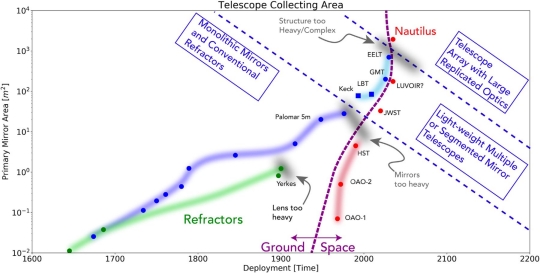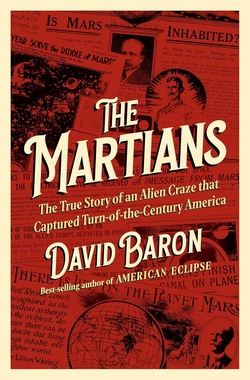Centauri Dreams
Imagining and Planning Interstellar Exploration
LHS 3844b: Rocky World’s Atmosphere Probed
These days we have a keen interest in small red dwarf stars (M-dwarfs) not only because they’re ideal for study, with deep transits of worlds in their habitable zones and the prospect of future analysis of their atmospheres, but also because they are so plentiful. Comprising perhaps 80 percent of all stars, they may well be home to the great majority of planets in the galaxy. And while they are common, they’re also long-lived, so that life would have plenty of opportunity to develop.
Now we have word of new work using both the Transiting Exoplanet Survey Satellite (TESS) and the Spitzer Space Telescope. TESS is, of course, a transit hunter, looking for the telltale dips in light from a parent star when a planet passes in front of it. The planet in question is LHS 3844b, about 48.6 light years out, and discovered by TESS in 2018. Follow-up observations in the infrared with Spitzer have detected light from the surface of this newly discovered world, allowing study of its atmosphere and composition. Note: This is not direct imaging; see below for more on the techniques used.
LHS 3844b orbits its star in 11 hours, making it almost certainly tidally locked; i.e., with one side always facing the star. The Spitzer data show that the dayside here reaches 770 degrees Celsius, while the nightside temperature is consistent with 0 Kelvin. In other words, the researchers could detect no heat being transferred from one side to the other, a process we would expect in the presence of an atmosphere.
Heat transfer is a mechanism that could ameliorate the effects of tidal lock, spreading warmth to the dark side and moderating global temperatures, but it takes an atmosphere to do that. We learn, then, that LHS 3844b is an object something like the Moon, or at any rate, a large version of it. Laura Kreidberg (Harvard-Smithsonian Center for Astrophysics), lead author of the paper that appears in Nature, says that this planet “…matches beautifully with our model of a bare rock with no atmosphere.” The scientist continues:
“We’ve got lots of theories about how planetary atmospheres fare around M dwarfs, but we haven’t been able to study them empirically. Now, with LHS 3844b, we have a terrestrial planet outside our solar system where for the first time we can determine observationally that an atmosphere is not present.”
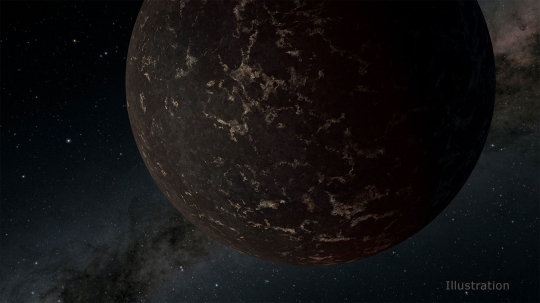
Image: This artist’s illustration depicts the exoplanet LHS 3844b, which is 1.3 times the mass of Earth and orbits an M dwarf star. The planet’s surface may be covered mostly in dark lava rock, with no apparent atmosphere, according to observations by NASA’s Spitzer Space Telescope. Credit: NASA/JPL-Caltech/R. Hurt (IPAC).
This is painstaking analysis indeed, drawing on phase curve data from the planet’s transits. Phase curves are a combination of reflected light and thermal emission from the planet. Unable to resolve the planet from the host star, astronomers must work with their combined light, and observe light variations of exquisite subtlety as planets go through phase changes as they orbit. A phase curve, then, is the time-dependent change in the brightness of a planet as seen from Earth during one orbital period.
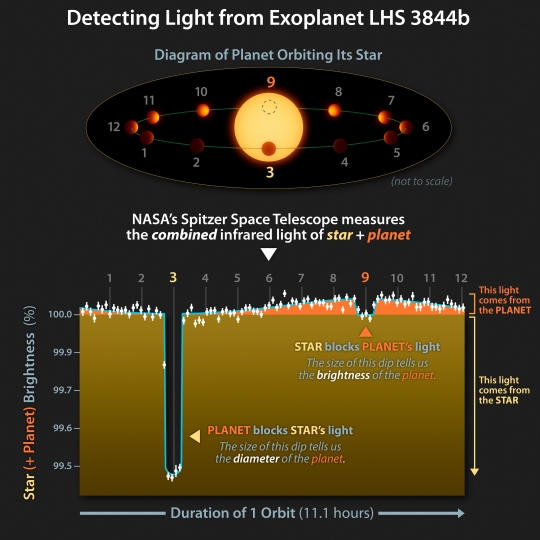
Image: Detecting Light from Exoplanet LHS 3844b. Credit: NASA/JPL-Caltech/L. Kreidberg (CfA | Harvard & Smithsonian).
Learning about the atmosphere (or lack thereof) of a small rocky world — LHS 3844b has a radius 1.3 times that of Earth — is therefore something of a coup, and bodes well for future discovery. The authors infer from the planet’s reflectivity (albedo) that it is covered with basalt, much like the mare of the Moon, which is probably an indication of volcanic activity in the distant past. From the paper:
We modeled the emission spectra of several rocky surfaces and compared with the measured planet-to-star flux… We considered multiple geologically plausible planetary surface types, including primary crusts that form from solidification of a magma ocean (ultramafic and feldspathic), secondary crust that forms from volcanic eruptions (basaltic), and a tertiary crust that forms from tectonic re-processing (granitoid). Governed by the reflectivity in the visible and the near-infrared and the emissivity in the mid-infrared, the surface types have distinct emission spectra. The measured planet-to-star flux for LHS 3844b is most consistent with a basaltic composition. Such a surface is comparable to the lunar mare and Mercury, and could result from widespread extrusive volcanism.
But this is a world much larger than the Moon, so what happened to its atmosphere? M-dwarf flare activity is thought to erode early planetary atmospheres, especially given how closely worlds like this orbit their star. The researchers rule out an atmosphere of over 10 bars (Earth’s atmospheric pressure at sea level is about 1 bar), and largely rule out one between 1 and 10 bars. They believe stellar winds and flares are the culprit. Modeling atmospheric escape over time, they assess how an early atmosphere dissolves within a magma ocean during planet formation or photolyzes into hydrogen and oxygen because of the intense bombardment of X-rays and UV from flares.
Thus a thick atmosphere is ruled out by the data, while stellar winds could account for further erosion of a thin atmosphere, all leading to the conclusion that LHS 3844b is a bare rock unless a thin atmosphere is replenished over time. Should we assume that hot terrestrial planets orbiting well inside the habitable zone of M-dwarfs are all devoid of atmospheres? Perhaps, but these stars may still be of astrobiological interest:
The results presented here motivate similar studies for less-irradiated planets orbiting small stars. Cooler planets are less susceptible to atmospheric escape and erosion, and may provide a friendlier environment for the evolution of life. In coming years this hypothesis can be tested, thanks to the infrared wavelength coverage of the James Webb Space Telescope and the influx of planet detections expected from current and future surveys.
The paper is Kreidberg et al., “Absence of a thick atmosphere on the terrestrial exoplanet LHS 3844b,” Nature 19 August 2019 (abstract / preprint)

Heliophysics with Interstellar Implications
You would think that heading toward the Sun, rather than away from it, would not necessarily fall under Centauri Dreams’ purview, but missions like the Parker Solar Probe have reminded us that extreme environments are ideal testing grounds for future missions. Build a heat shield that can take you to within 10 solar radii of our star and you’re also exploring possibilities in ‘sundiver’ missions that all but brush the Sun in a tight gravity assist.
Or consider the two proposals NASA has just selected in the area of small satellite technologies, which grow directly out of its heliophysics program. Here, the study of the Sun’s interactions with the Solar System, and the consideration of Sun, planets and heliosphere as a deeply interconnected system, takes pride of place. Let’s start with a mission called SETH — Science-Enabling Technologies for Heliophysics. One of its two technology demonstrators, called the HELio Energetic Neutral Atom (HELENA) detector, involves solar energetic neutral atoms, which can provide advanced warnings of potential radiation threats to astronauts.
The other demonstrator aboard SETH is an optical communications technology expressly designed for CubeSats and other small satellites, one that could allow a hundred-fold increase in the return of deep space data. Building out a robotic infrastructure in the Solar System will involve increasingly miniaturized technologies. We can envision small satellite constellations that can network and operate one day in ‘swarm’ fashion to create a continuous presence around targets ranging from asteroids to the gas and ice giants that can shape their orbits.

Image: NASA has selected two proposals to demonstrate technologies to improve science observations in deep space. The proposals could help NASA develop better models to predict space weather events that can affect astronauts and spacecraft, such as coronal mass ejections (CMEs). In this image, taken by the Solar and Heliospheric Observatory on Feb. 27, 2000, a CME is seen erupting from the Sun, which is hidden by the disk in the middle, so the fainter material around it can be seen. Credit: ESA/NASA/SOHO.
Toward a Large Solar Sail
But if you’re looking for a mission with real interstellar punch, consider Solar Cruiser, whose two technology demonstrations involve measurements of the Sun’s magnetic field structure and the velocity of coronal mass ejections (CMEs), those vast explosions of plasma that can create space weather nightmares for utility grids on Earth. Making this mission possible will be a solar sail of almost 1,700 square meters. The timing on this proposal seems propitious given The Planetary Society’s recent success at raising the orbit of LightSail-2 using sunlight. Pushing toward much larger designs is the next step.
“This is the first time that our heliophysics program has funded this kind of technology demonstration,” said Peg Luce, deputy director of the Heliophysics Division at NASA Headquarters. “Providing the opportunity to mature and test technologies in deep space is a crucial step towards incorporating new techniques into future missions.”
Solar Cruiser would also carry two tech demos
?? A nearly 18,000-square-foot solar sail that would demonstrate the ability to use solar radiation as a propulsion system
?? An instrument called a coronagraph that would help scientists study explosions of material from the Sun pic.twitter.com/ZFCLwm4GTy
— NASA Sun & Space (@NASASun) August 15, 2019
Lots to work with here, and I’m drawing together more information about Solar Cruiser, which would not only be by far the largest solar sail yet deployed, but would also experiment with using the momentum of sunlight to continuously modify its orbit. This would allow us to obtain views of the Sun that orbits involving gravity alone would not make possible. Robert Forward explored the original concept and introduced it to the public first in the pages of Analog and then in his book Indistinguishable from Magic (1995), where he considered how we might use such spacecraft near the Earth. He called a spacecraft that uses a solar sail to hover over a region rather than orbiting the Earth a ‘statite,’ and explained it this way:

…I have the patent on it — U.S. Patent 5,183,225 “Statite: Spacecraft That Utilizes Light Pressure and Method of Use”… The unique concept described in the patent is to attach a television broadcast or weather surveillance spacecraft to a large highly reflective lightsail, and place the spacecraft over the polar regions of the Earth with the sail tilted so the light pressure from the sunlight reflecting off the lightsail is exactly equal and opposite to the gravity pull of the Earth.
Here we are using a solar sail for station-keeping rather than transport, and Solar Cruiser may turn out to be the first time we experiment with the technique, which offers options that other kinds of satellite do not:
With the gravity pull nullified, the spacecraft will just hover over the polar region, while the Earth spins around underneath it. Since the spacecraft is not in orbit around the Earth, it is technically not a satellite, so I coined the generic term ‘statite’ or ‘-stat’ to describe any sort of non-orbiting spacecraft (such as a ‘weatherstat’ or ‘videostat’ or ‘datastat’).
Image: Analog‘s December, 1990 issue contained an article by Robert Forward describing the ‘polesitter’ concept, one of many innovative ideas the scientist introduced to a broad audience. Credit: Condé Nast.
Can Solar Cruiser push these ideas forward in orbits near the Sun? Forward called orbits that are non-Keplerian ‘displaced orbits’ and also referred to such satellites as ‘polesitters.’ It will be fascinating to see how far Solar Cruiser will explore such capabilities as part of its larger mission, which should also teach us much about large sail materials and deployment.
What will follow is a nine-month study period, with both proposals funded at $400,000 for concept studies, after which one of the two proposals will be selected to go into space. Launch will take place in October of 2024 as a secondary payload along with the Interstellar Mapping and Acceleration Probe (IMAP) probe, another mission we’ll be following closely as it investigates the interactions of the solar wind with the local interstellar medium (the spacecraft will orbit the Sun-Earth L1 Lagrangian point and will also be used to monitor space weather).
Also of interest: Baig and McInnes, “Light-Levitated Geostationary Cylindrical Orbits are Feasible,” Journal of Guidance, Control and Dynamics, Vol. 33, No. 3 (2010), pp. 782-793 (abstract).

Looking for Life Under Flaring Skies
The faint glow of a directly imaged planet will one day have much to tell us, once we’ve acquired equipment like the next generation of extremely large telescopes (ELTs), with their apertures measuring in the tens of meters. Discovering the makeup of planetary atmospheres is an obvious deep dive for biosignatures, but there is another. Biofluorescence, a kind of reflective glow from life under stress, could be detectable in some conditions at astronomical distances.
New work on the matter is now available from Jack O’Malley-James and Lisa Kaltenegger, at Cornell University’s Carl Sagan Institute. The duo have been on the trail of biofluorescence for some time now, and in fact their paper in Monthly Notices of the Royal Astronomical Society picks up on a 2018 foray into biosignatures involving the phenomenon (citation below). Here the question is detectability in the context of biofluorescence as a protective mechanism, an ‘upshift’ of damaging ultraviolet into longer, safer wavelengths.
“On Earth, there are some undersea corals that use biofluorescence to render the sun’s harmful ultraviolet radiation into harmless visible wavelengths, creating a beautiful radiance,” says Kaltenegger.” Maybe such life forms can exist on other worlds too, leaving us a telltale sign to spot them.”
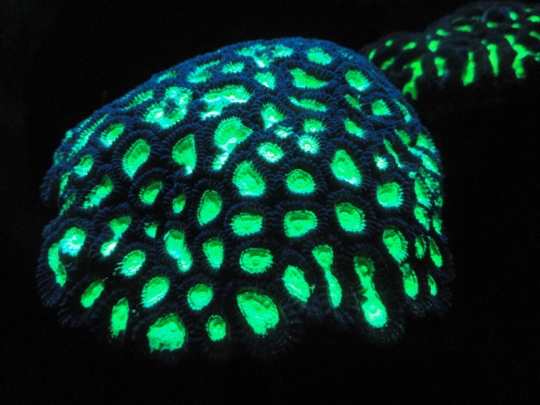
Image: An example of coral fluorescence. Coral fluorescent proteins absorb near-UV and blue light and re-emit it at longer wavelengths. Credit: Available under Creative Commons CC0 1.0 Universal Public Domain Dedication.
Biofluorescence in vegetation is an effect that is detectable from Earth orbit. Here the effect is comparatively small, accounting for 1-2 percent of the vegetation reflection signal, but of course it is also widespread given the coverage of vegetation over much of Earth’s surface. The phenomenon is also seen in corals, which produce a higher degree of fluorescence. Earth levels of biofluorescence are clearly too small to act as useful biosignatures for exoplanets, but higher levels may well occur elsewhere.
That’s because our early work on the atmospheres of Earth-sized planets will delve into systems around small M-dwarf stars. Such worlds are plentiful and the Transiting Exoplanet Survey Satellite (TESS) is expected to add to our inventory of habitable zone examples nearby. Even now, we have interesting targets: Proxima Centauri b, Ross 128b, TRAPPIST-1e, -f, -g, LHS 1140-b, for example, all of which orbit M-dwarf stars. And M-dwarf stars are known to flare.
This, in fact, is one of the cases originally made against life in such systems, for extreme X-Ray and UV radiation would create a challenging environment for even the simplest lifeforms. M-dwarfs vary in terms of the amount of radiation they produce; indeed, a planet around an inactive M-dwarf receives a lower dose of ultraviolet than Earth. But planets around active stars, particularly given the fact that the habitable zone is so close to the small star, receive much higher flux, and such flaring remains active for longer on M-dwarfs than on stars like the Sun.
Life could conceivably flourish underground on such worlds, or within oceans, but even on Earth, the authors note, we see biological responses like protective pigments and DNA repair pathways that are ways of mitigating radiation damage. The corals mentioned above use biofluorescence to reduce the risk of damage to symbiotic algae, absorbing blue and ultraviolet photons and re-emitting them at longer wavelengths.
Corals that display this phenomenon cover a mere 0.2 percent of the ocean floor, making for only a tiny change in our planet’s visible flux. But the situation could be different in actively flaring M-dwarf systems. To study the matter, O’Malley-James and Kaltenegger begin with a biofluorescent surface biosphere in a shallow, transparent ocean, adjusting the variables to simulate different ocean conditions. They vary fluorescent protein absorption and emission to produce values for reflected and emitted light. The assumption is that life evolving in conditions of extreme UV flux will produce ever more efficient fluorescence, in terms of absorbed vs, emitted photons (at maximum efficiency, all photons are absorbed and re-emitted).
The authors calculate the UV flux for different classes of M-dwarfs and quantify the outgoing emissions of common pigments during fluorescence. The model also includes atmospheric effects with varying cloud coverage, generating spectra and colors for hypothetical planetary conditions. False positives from mineral fluorescence are considered, as are signals produced by surface vegetation, with different fractions of surface coverings and biofluorescent life.
But let’s cut to the chase. A biosphere otherwise hidden from us could be revealed through the temporary glow resulting from the flare of an M-dwarf. From the paper:
Depending on the efficiency of the fluorescence, biofluorescence can increase the visible flux of a planet at the peak emission wavelength by over an order of magnitude during a flare event. For comparison, the change in brightness at peak emission wavelengths caused by biofluorescence could increase the visible flux of an Earth-like planet by two orders of magnitude for a widespread biofluorescent biosphere and clear skies, with low-cloud scenarios being more likely for eroded atmospheres. In an M star system, the reflected visible flux from a planet will be low due to the host star’s low flux at these wavelengths; however, the proposed biofluorescent flux is dependent on the host star’s UV flux, resulting in additional visible flux that is independent of the low stellar flux at visible wavelengths. This suggests that exoplanets in the HZ of active M stars are interesting targets in the search for signs of life beyond Earth.
Video: Lisa Kaltenegger, director of Cornell University’s Carl Sagan Institute, explains why studying bioluminescence on Earth can guide the way humans search for life on other planets.
If biofluorescence can evolve on the planets of active M-dwarf stars, it may turn out that high ultraviolet flux could be the key to reveal its existence. We need to quantify such effects because our ground- and space-based assets in the hunt for biosignatures are going to be homing in on the most readily studied planets first, and that means nearby worlds around red dwarfs. What O’Malley-James and Kaltenegger are doing is charting one possible signature that we may or may not find, but one which we now know to include in our investigative toolkit.
The paper is O’Malley-James and Kaltenegger, “Biofluorescent Worlds – II. Biological fluorescence induced by stellar UV flares, a new temporal biosignature,” Monthly Notices of the Royal Astronomical Society 13 August 2019 (abstract/full text). The earlier paper on this issue is O’Malley-James and Kaltenegger, “Biofluorescent Worlds: Biological fluorescence as a temporal biosignature for flare stars worlds,” accepted at MNRAS (preprint).

Modeling Early JWST Work on TRAPPIST-1
So much rides on the successful launch and deployment of the James Webb Space Telescope that I never want to take its capabilities for granted. But assuming that we do see JWST safely orbiting the L2 Lagrange point, the massive instrument will stay in alignment with Earth as it moves around the Sun. allowing its sunshield to protect it from sunlight and solar heating.
Thus deployed, JWST may be able to give us information more quickly than we had thought possible about the intriguing system at TRAPPIST-1. In fact, according to new work out of the University of Washington’s Virtual Planetary Laboratory, we might within a single year be able to detect the presence of atmospheres for all seven of the TRAPPIST-1 planets in 10 or fewer transits, if their atmospheres turn out to be cloud-free. Right now, we have no way of knowing whether any of these worlds have atmospheres at all. A thick, global cloud pattern like that of Venus would take longer, perhaps 30 transits, to detect, but is definitely in range.
“There is a big question in the field right now whether these planets even have atmospheres, especially the innermost planets,” says Jacob Lustig-Yaeger, a UW doctoral student who is lead author of the paper on this work. “Once we have confirmed that there are atmospheres, then what can we learn about each planet’s atmosphere — the molecules that make it up?”
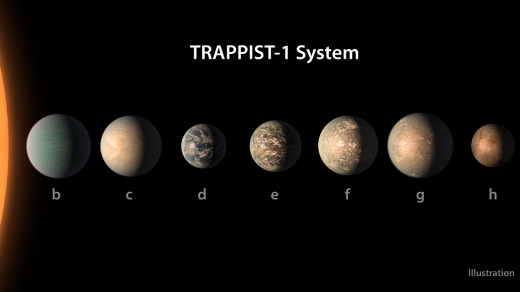
Image: New research from UW astronomers models how telescopes such as the James Webb Space Telescope will be able to study the planets of the intriguing TRAPPIST-1 system. Credit: NASA.
Working with Lustig-Yaeger are UW’s Victoria Meadows, principal investigator for the Virtual Planetary Laboratory, and doctoral student Andrew Lincowski. The latter should be a familiar name if you’ve been following TRAPPIST-1 studies, because back in November of 2018 he was lead author on a paper on climate models for this fascinating system (see Modeling Climates at TRAPPIST-1).
We’ll now be hoping to follow up that work with early JWST data. Briefly, Lincowski and team pointed to the extremely hot and bright early history of TRAPPIST-1, a tiny M-dwarf 39 light years out with a radius not much bigger than Jupiter (although with considerably more mass — the star is about 9 percent the mass of the Sun). These early conditions could produce planetary evolution much like Venus, with evaporating oceans and dense, uninhabitable atmospheres. The Lincowski paper, though, did point to TRAPPIST-1 e as a potential ocean world.
These findings were in the context of a system among whose seven transiting worlds are three — e, f and g — that are positioned near or in the habitable zone, where liquid water might exist on the surface. Now we have Lustig-Yaeger and company modeling our early JWST capabilities. The paper finds that beyond the presence of an atmosphere, we may be able to draw further conclusions, particularly with regard to the evolution of what gas envelopes we find.
Although oxygen as a biosignature may not be detectable for the potentially habitable TRAPPIST-1 planets, oxygen as a remnant of pre-main-sequence water loss may be easily detected or ruled out… the 1.06 and 1.27 µm O2-O2 CIA [collisionally-induced absorption] features are key discriminants of a planet that has an oxygen abundance greatly exceeding biogenic oxygen production on Earth and may therefore indicate a planet that has undergone vigorous water photolysis and subsequent loss during the protracted super-luminous pre-main-sequence phase faced by late M dwarfs,,,
Such features could be detected fairly quickly:
… in as few as 7-9, 15, 8, 49-67, 55-82, 79-100, and 62-89 transits of TRAPPIST-1b, c, d, e, f, g, and h, respectively, should they possess such an atmosphere. These quoted number of transits may be sufficient to rule out the existence of oxygen-dominated atmospheres in the TRAPPIST-1 system. Additional evidence of ocean loss could be provided by detection of isotope fractionation, which may also be possible in as few as 11 transits with JWST.
Moreover, the authors find that water detection could help to pare down various evolutionary scenarios on these worlds, particularly for TRAPPIST-1 b, c and d, assuming atmospheres high in oxygen content that have not been completely desiccated by the star’s early history. Thus we are probing planetary evolution, but assessments of habitability are going to be tricky, and it seems clear that we will need to turn such analysis over to future direct-imaging missions.
On balance, we are talking about getting useful results with a fairly low number of transits. JWST’s onboard Near-Infrared Spectrograph will use transmission spectroscopy — where the star’s light passes through a planet’s atmosphere to reveal its spectral ‘fingerprint’ — to detect the presence of an atmosphere via the absorption of CO2. Such analysis can likewise either detect or rule out oxygen-dominated atmospheres, while constraining the extent of water loss through measurements of H2O abundance. All of this provides fodder for other, still evolving observing strategies using the JWST instrument package that can begin the characterization of these compelling worlds.
The paper is Lustig-Yaeger et al., “The Detectability and Characterization of the TRAPPIST-1 Exoplanet Atmospheres with JWST,” Astronomical Journal Vol. 158, No. 1 (21 June 2019). Abstract / preprint. The Lincowski paper referenced above is “Evolved Climates and Observational Discriminants for the TRAPPIST-1 Planetary System,” Astrophysical Journal Vol. 867, No. 1 (1 November 2018). Abstract / Preprint.

Nautilus: New Lens Concept for Space-based Array
As we’ve been talking about the limitations of giant telescopes in recent days — and a possible solution in David Kipping’s idea of a ‘terrascope’ — it pays to keep in mind how our ability to collect light has changed over the years. Thus the figure below, which is drawn from a new paper from Daniel Apai and Tom Milster (both at the University of Arizona) and colleagues. Here we see four centuries of evolution for light-collecting power through refracting and reflecting telescopes, with the introduction of segmented mirrors making larger apertures possible.
Image: This is Figure 1 from the paper (click to enlarge). Caption: Evolution of light-collecting area of ground-based (blue, green) and space-based (red) telescopes. The evolution is characterized by alternating stages of slow growth (when existing technology is scalable) and pauses (when existing technology cannot be scaled up). The data points represent the installation of the largest telescopes in their era and are connected to highlight general trends. Gray regions mark the approximate stages in the evolution when lenses, monolithic mirrors, and then segmented mirrors become to massive to be viable with existing technology. Telescopes used multiple different technological solutions to collect light. Large jumps in diameter are due to change in technology due to technological breakthroughs. Credit: Daniel Apai / Tom Milster / UA.
Anticipated designs for space telescopes take us from Hubble’s 2.4-meter mirror up to the segmented mirrors of the James Webb Space Telescope (6.5 meters) and future concepts like the Large UV/Optical/IR Surveyor (LUVOIR), with a 15-m primary telescope. The gradual growth of aperture sizes is, Apai and Milster argue in their paper, a bottleneck in the design of astronomical telescopes, and one we’ll have to overcome to study Earth-like planets and their potential biosignatures.
What the scientists are offering is a telescope concept in which the primary mirror is replaced by what the authors describe as multiorder diffractive engineered (MODE) material lens technology. Here we move from refraction, which involves light changing direction as it moves from one medium to another, to diffraction, where the waves of light change direction as they encounter barriers and openings in their path — think Fresnel lenses, where waves can interact constructively or destructively depending on wavelength. The MODE lens developed at UA by the authors is in effect a hybrid between refractive and diffractive lens technologies.
In their paper, Apai and Milster propose a space telescope called Nautilus, which would operate as a fleet of 35 14-meter wide spherical telescopes, each of them more powerful than the Hubble instrument. Within each Nautilus unit, an 8.5-meter diameter MODE lens would be used for high-precision transit spectroscopy, along with a 2.5 meter lens optimized for wide-field imaging and transit searches. The combined array would be powerful enough to characterize 1,000 exoplanets from a distance as far as 1,000 light years. The light-collecting power Nautilus achieves, by the authors’ calculations, is the equivalent of a 50-meter diameter telescope.
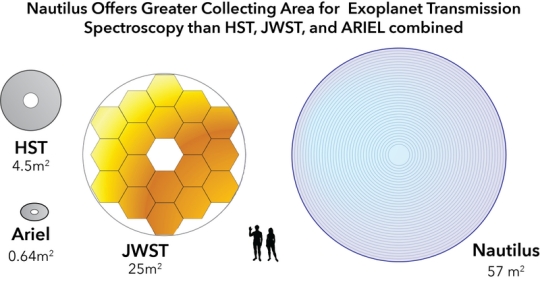
Image: Each individual Nautilus lens is 8.5 meters in diameter, larger than the mirrors of the Hubble Space Telescope and James Webb Space Telescope. Credit: Daniel Apai.
The authors argue that “…the concept described here offers a pathway to break away from the cost and risk growth curves defined currently by mirror technology and has the potential to enable very large and very lightweight, replicable technology for space telescopes.” Such lenses are less sensitive to misalignments and deformations than conventional refractive lenses and are readily replicated through processes of optical molding. Says Apai:
“Telescope mirrors collect light – the larger the surface, the more starlight they can catch. But no one can build a 50-meter mirror. So we came up with Nautilus, which relies on lenses, and instead of building an impossibly huge 50-meter mirror, we plan on building a whole bunch of identical smaller lenses to collect the same amount of light.”
These lenses work via a design the authors have patented, one that allows them to be both large and far lighter than monolithic mirrors. Large aperture lenses using diffractive methods can be produced without the mass and volume of material required by refractive designs. They are much thinner, formed around a series of separate sections mounted in a frame. The easiest analogy is with lighthouse lenses, which are built around concentric annular sections.
That makes them less expensive to launch, but the design also takes into account the practicalities of the space launch business, with the capability of stacking individual modules on top of each other. The lenses are 10 times lighter in areal density and 100 times less sensitive to misalignments. Thus the potential is here to sharply reduce launch costs as well as the cost of initial fabrication through a series of instruments using replicated components and identical telescopes — with a fleet of 35 in play, Nautilus collects light efficiently and distributes risk among multiple instruments. That latter point resonates given how much rides on a successful launch and deployment of missions like the James Webb Space Telescope.
“Currently, mirrors are expensive because it takes years to grind, polish, coat and test,” adds Apai. “Their weight also makes them expensive to launch. But our Nautilus technology starts with a mold, and often it takes just hours to make a lens. We also have more control over the process, so if we make a mistake, we don’t need to start all over again like you may need to with a mirror.”
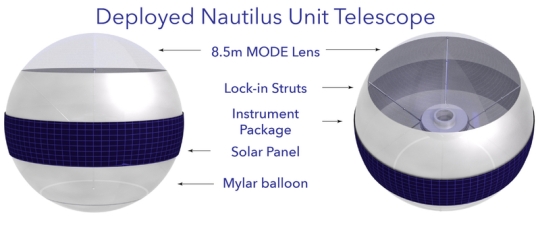
Image: A labeled illustration of an individual Nautilus unit. It is designed to stack many units on top of each other in a rocket before inflating in space. Credit: Daniel Apai.
The paper takes note of the scalability of the concept:
Due to its relatively low production and launch costs and the identical multispacecraft model that is relatively new to astrophysical space telescopes, the general Nautilus system proposed here provides an easily scalable approach. Such multispacecraft models (multiple identical units) are used commercially (Iridium system) and for geo- and planetary sciences (Voyagers, Mariners, Mars exploration rovers, etc.) to reduce per-unit costs and risks and to extend capabilities. Furthermore, telescopes utilizing similar architecture but increasing in size could demonstrate feasibility and mitigate risks, while producing scientific data.
If the Nautilus model works, the prospect of low-cost space telescopes far more powerful than anything now in space or planned for it opens up, bringing such capabilities to the level of individual universities, who could launch their own small instruments. That would be quite a switch from the current model of having to compete for time on overbooked space observatories like Hubble. And Nautilus itself gives us the potential for observing 1,000 Earth-like planets within the 1,000 light years the light-collecting power of Nautilus is designed to investigate.
The paper is Apai et al., “A Thousand Earths: A Very Large Aperture, Ultralight Space Telescope Array for Atmospheric Biosignature Surveys,” Astronomical Journal Vol. 158, No. 2 (29 July 2019). Abstract.

The Terrascope: Challenges Going Forward
Yesterday I renewed our acquaintance with the idea that large natural objects can stand in for technologies we have previously been engineering into existence. The progression is a natural one. The early telescope work of Hans Lippershey and Galileo Galilei began with small instruments, but both refractor and later reflector designs would grow to enormous size, so that today, even with the best adaptive optics and segmented mirrors working together, we are pushing hard on what can be done. Not to mention the fact that controversies over land use can come into play with gigantic observatory installations, as we’ve seen recently in Hawaii.
The fascination is that there is nothing in physical law to preclude ever increasing segmented mirror instruments, but we have to question their economic realities and their practicality. I think it’s a nod to the sheer ingenuity involved in linking seemingly disparate phenomena that David Kipping could turn work on the ‘green flash’ seen at sunrise and sunset into, first, the realization that the refractive flash would be a globe-circling ring as seen from space when the Earth occulted the Sun, and second, into the idea that it marked a potentially usable lensing phenomenon.
Here we’re letting nature do the work. Using the Earth as a lens would allow us to extend our powers remarkably, and at comparatively low cost. Working with a one-meter detector of the sort we already know how to fly (Hubble uses a 2.4-meter mirror), we could achieve results we would expect from a 150-meter space telescope. Assuming, of course, that Kipping’s recent analysis is correct, or more accurately, that the issues he identifies in the paper are solvable and our imaging technologies are up to the task.
For we start digging into the challenging bits almost as soon as the concept is explained. What Kipping wants to exploit is the fact that light from a star behind the Earth would undergo refractive lensing as it entered and then exited the atmosphere. Crucially, the focal point this would create as light rays bent around the Earth and converged on the other side would vary in distance depending on the altitude in the atmosphere that the light passed. This would give us a focal line, so that as we moved further away from the Earth, we would be experiencing the lensing of light at higher and higher altitudes.
The Perils of Extinction
I hope by now the point is clear that because we are talking about light in the atmosphere, we have to be aware of all the extinction events — loss of light — that could occur, from low-level light being obscured by topographical features to much higher weather causing disruption in our seeing. Extinction is dependent on the color, or wavelength, of light in question, and we also have to take scattering effects into consideration.
But Kipping believes that light lensed from about 14 kilometers would be relatively free of these effects, allowing a robust image to be potentially acquired. The focal line sampled at roughly the distance of the Hill Sphere (about four times Earth-Moon distance) is thus what we’re after. Moreover, the alignment doesn’t have to be exact. It could be offset by about an Earth diameter.
Have a look at the figure below, drawn from Kipping’s paper, which shows the extinction expected at various distances from the Earth, and you’ll see that the most robust acquisition of signal is going to be at the Hill sphere distance.
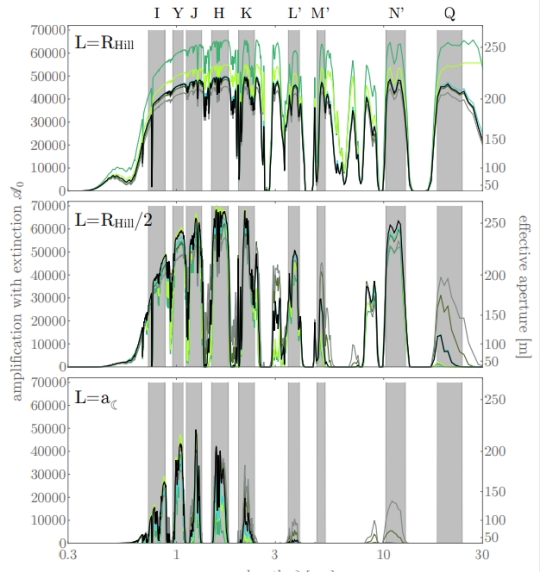
Image: This is Figure 11 from the paper. Caption: Amplification after extinction expected for a 1 metre diameter telescope at the Earth’s Hill radius (top), half the Hill radius (middle) and the Moon’s separation (bottom). Six atmosphere models are shown… [the color coding is provided in the paper, q.v.], which control temperature-pressure profiles (and thus refractivity profile) as well as the extinction computed using lowtran7 [a propagation model and computer code for predicting atmospheric transmittance and sky thermal and scattered radiance]. All models assume no clouds. Standard photometric filters highlighted in gray, except for L, M and N which are slightly offset to encompass the optimal regions. Credit: David Kipping.
As you see, these models assume no clouds, but we must take into effect the fact that at any given time, clouds cover approximately three-quarters of the Earth, meaning they can block out the desired signal. The Hill sphere distance is, in Kipping’s estimation, sufficient to bypass the bulk of these. His calculations show that light passing through the atmosphere at an altitude of 14 kilometers should display a net loss of about eight percent, small enough to make the concept of the Terrascope viable.

Image: This is Figure 13 from the paper. Estimated transmission through the Earth’s atmosphere due to clouds for a Terrascope detector at a distance L. At one Hill radius (1,500,000 km), lensed rays travel no deeper than 13.7 km and thus largely avoid clouds, thereby losing less than 10% of the lensed light. Credit: David Kipping.
Parts of the Earth which are illuminated are a problem, because they insert a background component to the desired signal. The author notes that “background suppression strategies, such as leveraging polarization, wavelength information, and temporal light curve variations” may be of value in reducing some of this loss, but he proceeds to account for the loss with a conservative halving of this original amplification figure to 22,500. An actual Terrascope may able to make this figure climb, though the paper does not explore the idea further.
On the matter of extinction and its problems due to clouds, it’s interesting to consider the Terrascope in other wavelengths. Kipping’s primary thrust here is in optical and infrared light, but the paper moves on to consider the interesting possibility of moving outside this range. From the paper:
Moving further out into the radio offers two major advantages… First, extinction due to clouds can be largely ignored, allowing for detectors much closer including on the lunar surface. Second, Solar scattering is far less problematic in the radio and indeed it is typical for radio telescopes to operate during daylight phases. The simple refraction model of this work was extended to the radio and indeed the amplification was estimated to be largely achromatic beyond a micron. Nevertheless, the model did not correctly account for the radio refractivity as a function of humidity, nor the impact of the ionosphere on lensed rays. Accordingly, a radio terrascope may be an excellent topic for further investigation.
A Path for Research
Limited by working with only those targets that are behind the Earth as seen from the spacecraft, we seem to be boxed in, but consider the possibility, which Kipping discusses in his video on the Terrascope, of creating a fleet of small detectors around the Hill sphere. Now the target list widens as we gain pointing control, and as we build out such a fleet, we can choose our early targets while anticipating the next high-priority items to be served by future detectors. The important first step is to find out whether a working Terrascope delivers on its promise.
Those with a long memory may recall my Centauri Dreams articles on Claudio Maccone’s FOCAL ideas in relation to creating not just a telescope but a radio bridge between distant targets for interstellar exploration [see, for example, The Gravitational Lens and Communications]. Could we do something similar to create a radio Terrascope? The paper gives a nod to the notion, and I asked Kipping if he could expand upon the idea, which he was kind enough to do yesterday.
“Any system like this can also be used in reverse, we can switch out the detector for a transmitter and suddenly we have an antenna with an amplification of 45,000 instead,” he wrote in an email. “In fact, it’s even easier because you don’t need an Earth-shade anymore. To realize this in the radio, there would need to be some further work on how the ionosphere affects the lensing but certainly the optical and infrared are already viable according to my study. One could imagine using this as the bedrock for an interplanetary high speed internet, enabling missions like Cassini and Juno to send back very high fidelity data.”
Given current limitations on data return from deep in the Solar System, the term ‘interplanetary high-speed internet’ seizes the imagination, which is why I’m going to make sure that Vinton Cerf, inventor of the TCP/IP protocols and a man who has done extensive work on extending these methods into forms adapted for Solar System distances, sees the Terrascope idea. Looking down the road, I can only imagine the effect on public support for robotic exploration of the outer system if we were able to offer high-speed data and virtual reality capabilities for our targets.
The benefit of exploring David Kipping’s ideas plays hand in glove with research into gravitational lensing. We’re talking in both cases about placing a detector at the right position to acquire data while minimizing background contamination, developing the needed occulter and creating the software to untangle what does get through from the lensed photons we want. But with the Terrascope, we are working close to home, and can experiment at relatively low cost with strategies for maximizing the acquisition of our imagery and the untangling of it. Much of this work would play directly into the development of the longer-term FOCAL mission.
We need to investigate these ideas. The collecting power of a 150-meter telescope, if it can be achieved as per this concept, takes us into the possibility of detecting topography on exoplanets, not to mention its potential for biosignatures as well as deep space astronomy. Moving further along will involve looking deeper into the question of atmospheric effects and occulter design, which is where Kipping believes the next research effort should be mounted.
The paper is Kipping, “The “Terrascope”: On the Possibility of Using the Earth as an Atmospheric Lens,” accepted at Proceedings of the Astronomical Society of the Pacific (abstract).

